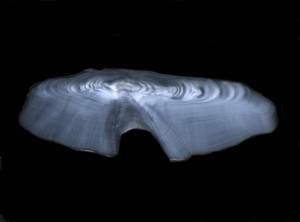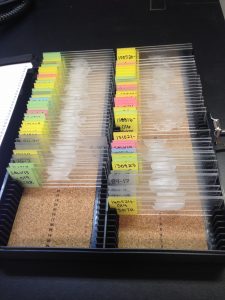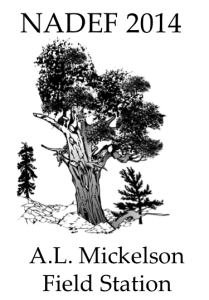I spent the last ten days at a very unexpected place for a marine ecology student to spend her summer. I took part in the 24th annual North American Dendroecological Fieldweek (NADEF) in the Shoshone National Forest near Yellowstone National Park.
Dendroecology: the application of tree-ring analysis to ecological questions.
What is someone studying nearshore fisheries doing at a fieldweek in the middle of the country dedicated to the study of tree-ring analysis? As it turns out, learning a whole lot. About 10 years ago, an ecologist by the name of Dr. Bryan Black (University of Texas) made the leap from a career as a forester to an ecosystem oceanographer. With him, he brought his extensive knowledge of tree-ring analysis and began applying it to hard structures in marine organisms that have annual rings very similar to tree rings. Of particular interest to me is the hard, inner-ear bone of fishes known as an otolith.
Scleroecology: the application of tree-ring analysis to hard structures in marine organisms to ecological questions.
NADEF was an incredibly fast-paced week spent with students, faculty and professionals from all over the world, and especially with a small group of individuals interested in improving our ability to use otoliths to better understand how environmental conditions influence fish growth. With this information, we can both reconstruct past climatic conditions and forecast what climate projections might mean for important fish stocks.
Over the course of about a week, we completed a growth chronology (1918-2006) of Pacific geoduck (Panopea generosa) collected in Haida Gwaii, and both growth and luminance chronologies (1948-2007) of Pacific Ocean Perch (Sebastes alutus) collected in the Bering Sea. Through I will be continuing both projects and working towards publication, anyone interested in learning more about both the growth and luminance chronologies can check out our initial project report here. Even in its initial stages, the chronologies reveal patterns in the Pacific Decadal Oscillation (PDO) and El Nino Southern Oscillation (ENSO) over the past century, and contribute information to our knowledge of how past climatic shifts have influenced both geoduck and POP stocks. Best of all, managers at the Fisheries Science Center in Alaska are engaged in the project and are excited to use information generated in future stock assessment efforts.
 .
. 
